Machinery
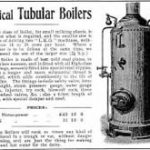
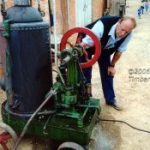
Status: Operational
J Bartram & Sons of 586-588 Bourke Street Melbourne specialised in machinery for the dairy and food processing industry. The ATT has one of the firm’s boilers built in August 1911 and mounted on a four-wheeled trolley along with a Tangye vertical pumping engine. A similar boiler and pump is held by the Museum of Victoria.
Such a boiler could be used to supply the wants of a small milking plant – steam for sterilization or to drive a milk separator, hot water for cleaning utensils and udders, a mechanical water pump for the milk-cooler, and a mechanical drive from the pump flywheel to a milking machine.
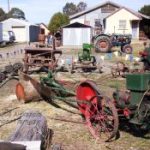
Status: Operational and under restoration
The ATT has a large collection of internal combustion engines, some restored and some under restoration. These include such makes as R. Hornsby, Ronaldson Bros & Tippett, H. V MacKay, International Harvester, Wolseley, Petter and Rosebery. These engines may be seen on special days such as those over Easter carrying out a range of tasks like cutting logs to length and operating a saw-bench.


Status: Operational
This 2nhp (nominal horse-power) portable steam engine was ordered by Marshall agents Robison Brothers of South Melbourne on 22 August 1906 and arrived in Australia on 10 December 1906 on the SS Port Phillip at a landed cost of £101 13s 0d. On 15 January 1909 it was sold to J. C. Dahlsen & Company of Bairnsdale for $133. Dahlsens were shipping agents on the Gippsland Lakes and operated paddle steamers, but had also diversified into other local industries such as sawmilling. This is the only 2nhp Marshall to have been imported into Australia by Robison Brothers and is reputed to be the only 2nhp Marshall portable under steam in Australia.


Status: Operational
This 8nhp (nominal horse-power) portable steam engine was ordered by Marshall agents Robison Brothers of South Melbourne on 18 April 1907 and arrived in Australia on 22 August 1907 on the SS Moravian at a landed cost of £273 7s 0d. On 16 September it was sold to C. L. Bottcher of Barham, NSW, for $302 10s 0d, being a 10{2dde95378de8e2986e0afae2860a6c1bdef4fb105db99c05daff134204cc4ac9} profit to Robison Brothers.
This type of engine was particularly suited to bush sawmills. The engine was large enough to run a small mill, easy to maintain, easy to shift, and required no heavy foundations or brickwork for its installation. This was important in an era where most mills were shifted to a fresh patch of bush every few years. An 8nhp engine could run a small “spot mill” with a single bench. Larger mills with separate benches for “breaking-down” and “ripping” the timber could process twice the volume of timber per day, but required double the power. The Forests Commission of Victoria would not normally issue a licence for a mill of less than 16nhp. Most sawmill engines were therefore of 16nhp and had two cylinders, although many smaller mills on private property and firewood mills continued to operate with a single cylinder engine.
Another two of this type of portable steam engine are on display at the ATT in un-restored condition.
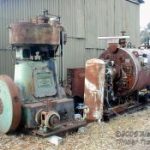
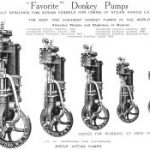
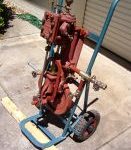
Status: Operational and awaiting restoration
Bellis & Morcom enclosed high-speed steam engine #9043
The largest stationary steam engine preserved at the ATT is a Bellis & Morcom enclosed high-speed steam engine formerly used in the Ruoak Timbers Pty Ltd sawmill at Alexandra. This represents the most modern steam engine preserved at the ATT. With its mechanism operating in an enclosed “sump” similar to that of a modern motor vehicle, lubrication was enhanced and wear reduced as the moving parts were protected from the ingress of dust and grit. This particular engine, builder’s number 9043, was donated to the ATT by J. L Gould Sawmills Pty Ltd, and was delivered with a Trevor packaged oil-fired boiler. This machinery will be installed under cover and returned to service when time and finances permit.
A. G. Mumford “banjo” donkey pump #9682
At the opposite end of the size scale is a small A. G. Mumford “Favourite” brand “donkey” pump. The rotative direct-acting donkey pump was very popular in the late nineteenth and early twentieth centuries. In this type of pump, the piston rod is directly connected to the pump plunger, with valve motion being generated from an eccentric on the crankshaft with a flywheel to carry the pump over its centres. This type of pump is often known as a “banjo” pump from the shape of the crank mechanism. Rotative direct-acting pumps produced by Alex. Wilson & Coy., Frank Pearn & Coy, Ransome Sims & Jeffries and A. G. Mumford in the United Kingdom remained popular into the twentieth century.
The pump preserved at Alexandra is similar to those pictured in an A. G. Mumford catalogue illustration of 1906, and came from an old sawmill in the Dorrigo (NSW) area. It carries the number 9682 stamped on the cylinder end cover, possibly the builder’s number. It has a bore of 2½-inches and a stroke of 2½-inches at the steam end, and a bore of 1¼-inches and a stroke of 2½-inches at the water end. At least four Mumford donkey pumps are known to survive in Victoria, two of this size and two of the slightly larger “No.3”.
The ATT has a large range of horizontal direct-acting duplex steam pumps and vertical direct-acting simplex steam pumps awaiting restoration.
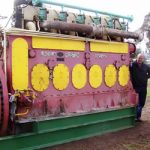
Status: Under Construction
Used at Lake Eildon from 1958 to 2006 as an emergency electricity supply and provider of additional pumping capacity
The Eildon hydro-electric power station was commissioned in 1956-57, following the completion of the new and enlarged Eildon weir. Shortly afterwards, it was realized that there was a serious design flaw with the electrically driven sump pumps and associated switch gear. They were situated just above the level of the tail race and while the capacity of the pumps was considered enough to keep normal water leakage at bay, in times of high levels of leakage or a mistake in operating the intake valves could produce more water than the pumps could cope with.
With the pumps below the surface and out of action, the water would quickly rise, flooding the station and its two 60MW generators. In addition, should both generators be out of action and the supply line between Eildon and Rubicon “A” fail, there would be no electricity to work any of the pumps.
Discussions between SEC engineers in 1958 confirmed that an emergency electricity supply and additional pumping capacity were urgently required. At this time, a large electrical supply plant from the diesel-powered Nhill power station in western Victoria became available.
The plant consisted of a Ruston 6-cylinder diesel engine Class VEB Mark 2, engine number 307545, built in early 1950 and dispatched from the factory in Lincoln in October 1950. This class of engine was produced between April 1939 and December 1962. Each cylinder has a bore of 10¼-inches and a stroke of 14½-inches. The engine weighs 13.33 tons and develops 360 bhp at a maximum of 500 rpm (396 bhp at peak load). It was direct-coupled to a 300KVA Brush alternator and exciter. The cost of moving the plant and re-installing it at Eildon was £2,650 and was completed by mid 1960.
In August 2006 a more compact plant was installed and happily the old plant has escaped the scrapper’s torch and is preserved at the Alexandra Timber Tramway on “long-term loan” from AGL-Hydro and is complete with its alternator, exciter and associated electrical switch gear. The engine had run at least four times in the week prior to its arrival in Alexandra.
The Ruston engine and generator exhibit will become part of a larger display as a tribute to the contribution made by hydro-electric power to the Alexandra district.

